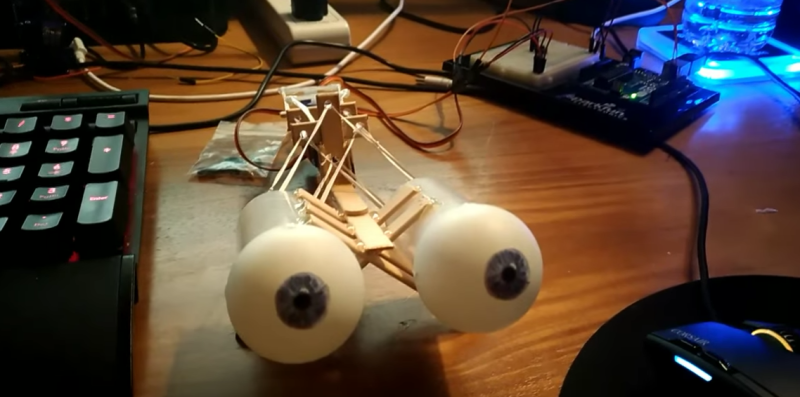Animatronics for movies is often about making something that works and is reliable in the short term. It doesn’t have to be pretty, it doesn’t have to last forever. [Corporate Sellout] shows us the minimalist approach to building animatronics with this pair of special eyes. These eyes move in both the pan and tilt. Usually, that means a gimbal style mount. Not in this case. The mechanical assembly consists of with popsicle sticks, ping-pong balls, film canisters and dental floss.
The frame for the eyes is made of simple popsicle sticks hot glued together. The eyes themselves are simple ping-pong balls. Arduino powered servos control the movement. The servos are connected to dental floss in a cable arrangement known as a pull-pull system. As each servo moves, one side of the arm pulls on a cable, while the other provides enough slack for the ping-pong ball to move.
Mounting the ping-pong balls is the genius part of this build. They simply sit in the open end of a couple of film canisters. the tension from the dental floss holds everything together. We’re sure it was a finicky setup to build, but once working, it’s reliable. Only a glue joint failure or stretch in the dental floss could cause issues.
There are plenty of approaches to Animatronic eyes. Check out the eyes in this Stargate Horus helmet, which just won our Sci-Fi contest. More recently we saw Gawkerbot, which uses a CD-ROM drive to provide motion for a creepy robot’s eyes.
















That’s actually really close to how the ligaments are attached in real eye balls, Impressive!
My brand!
I’m glad I’m not the only one that had that clip be the first thing that popped into my head when reading the title.
I’m 100% sure the title is a deliberate reference, and I am surprised they didn’t link the video in the article.
https://www.youtube.com/watch?v=V-fRuoMIfpw
You’re right!
Sharing videos like this is why I have not friends.
I did no maen two rite not?
Very nice! I’ll be bookmarking this one.
eyes will be watching
https://www.youtube.com/watch?v=bjfMVqL344Y
^ That + The eyes + Prosthetic Hand with servos + mannequin head + TTS UNIT
My HACK!
Are there less noisy options for doing such things?
Good point.
You could use muscle wire, but I understand that very precise lengths are difficult to control in practice. Pneumatic muscles are effectively silent, but air pumps usually are not.
Some sort of magnetic, contactless actuator could be made by putting magnets in the eyes and applying force from electromagnets, but again precise control would require either very accurate voltage control or or PWM, which could introduce its own noise.
You could replace the cheap hobby servos with quieter motors, but those motors would probably require gearboxes to improve resolution and increase torque, and the gears are where the noise really comes from.
Personally, I think the best solution would be to switch to brass-geared servos, mount the servos on rubber spaces, and surround them in a muffling fabric/felt/foam enclosure.
Thanks, thats at least something. What about linear actuators/motors? I want to move a skeletons jaw to a voice signal, so it shoudl be silent.
Muscle Wire (Shape memory) alloy could work.
simply put the servos elsewhere and in a place where you can sound control them. this can easily be adapted to use a pair of throttle cables and put the servos down in the abdomen
Using the mechanism(s) from digital camera(s) and sufficient soundproofing with foam should work.
That’s a wonderful technique and very robust. I’ve used it for moving eyes on photographs. One advantage is that you can make the floss as long as you need to, so the servo noise problem can disappear if you put the servos a good distance away.
The build quality in that sample is impressive too. I’ll be bookmarking that video for sure! Thanks for sharing it.
Or, grasp the balls and manipulate them with your hands.
Simple and reliable. Quiet? That depends…
Jeeze it never would have occurred to me I could get a hackaday post out of mine….
http://i.imgur.com/6qIsuOJ.jpg
here’s an earlier version as a video:
https://www.youtube.com/watch?v=qveOclwMnms
Why not?!?!
But… do they work with X?
Eyeballs? Make them punk and a tad lower….
Hello, I am the maker of this video and robot. I only just found out now that I had been featured here, thanks everyone for the kind words! And yes, it was 100% a refrenece to the video “MY BRAND!” haha
This looks like something which could be greatly optimized with the entire mounting system designed in FreeCAD and 3D printed. Just add servos, strings and ping pong balls.